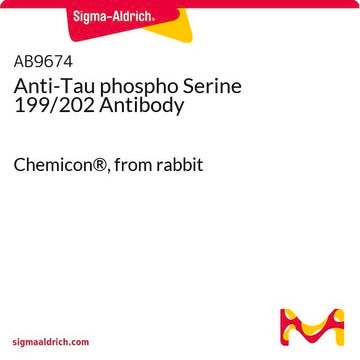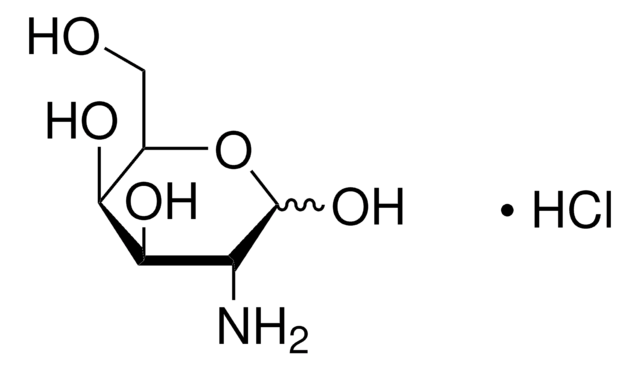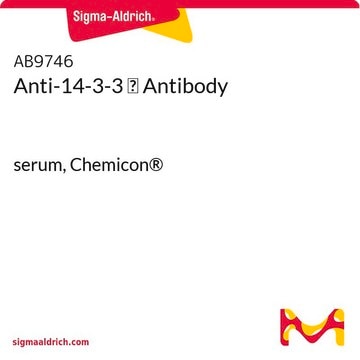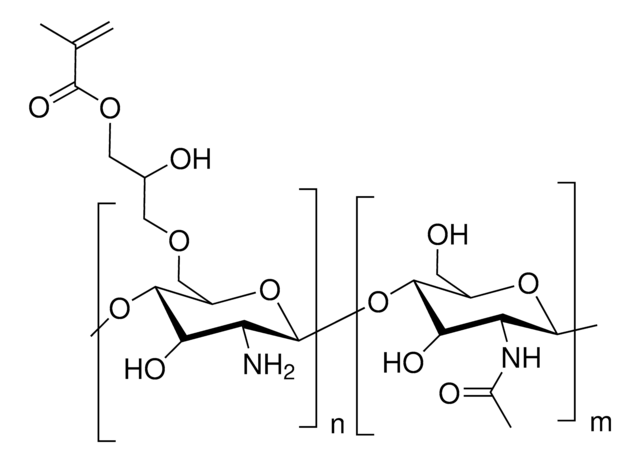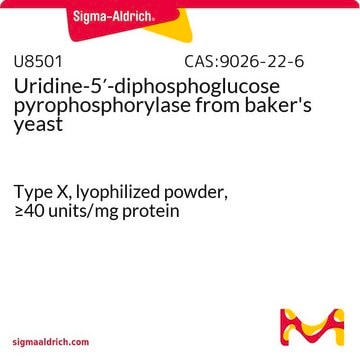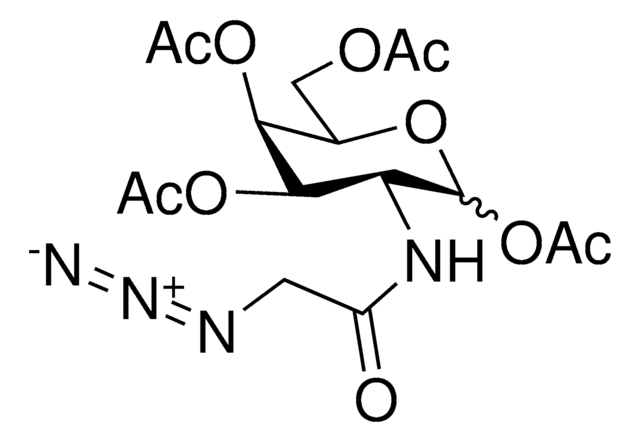Recommended Products
biological source
rabbit
Quality Level
antibody form
serum
antibody product type
primary antibodies
clone
polyclonal
species reactivity
human, mouse, rat, bovine, rabbit, sheep, chicken
manufacturer/tradename
Chemicon®
technique(s)
immunohistochemistry: suitable
western blot: suitable
NCBI accession no.
UniProt accession no.
shipped in
dry ice
target post-translational modification
unmodified
Gene Information
human ... YWHAH(7533)
General description
Mammals express seven distinct 14-3-3 isoforms (gamma, epsilon, beta, zeta, sigma, eta, tau) that form multiple homo- and hetero- dimmers, thus rendering 14-3-3 as a key multifunctional regulatory molecule. 14-3-3 isomers have been implicated in several neurological disorders: for example isoforms gamma, epsilon and beta are expressed in the cerebrospinal fluid of Creutzfeldt-Jakob patients, but not patients suffering from other neurological conditions such as Alzheimer′s.
The 14-3-3 eta antibody is one of a panel of antibodies that were generated against 14-3-3 isoforms and have demonstrated their potential for use as an ELISA-based diagnostic tool. These antibodies will allow the research to investigate the role of this protein in key cellular processes and neurological disorders such as Creutzfeldt-Jakob, Alzheimer′s and Parkinson′s Disease.
The 14-3-3 eta antibody is one of a panel of antibodies that were generated against 14-3-3 isoforms and have demonstrated their potential for use as an ELISA-based diagnostic tool. These antibodies will allow the research to investigate the role of this protein in key cellular processes and neurological disorders such as Creutzfeldt-Jakob, Alzheimer′s and Parkinson′s Disease.
Specificity
14-3-3 eta. By Western blot the antibody recognizes the ~30 kDa protein.
Immunogen
Synthetic peptide from the N-terminal area of sheep 14-3-3 eta.
Application
Anti-14-3-3 η Antibody detects level of 14-3-3 η & has been published & validated for use in WB, IH.
Research Category
Neuroscience
Neuroscience
Research Sub Category
Neurodegenerative Diseases
Neurodegenerative Diseases
Western blot: 1:3,000 using ECL.
Immunohistochemistry: 1:1,600-1:3,200 on mouse brain tissue which was treated by hydrated autoclaving at 121°C for 15 minutes prior to immunolabeling. Endogenous peroxidase was blocked with hydrogen peroxide in methanol and non-specific labeling with normal goat serum at 1:20 for 5 minutes.
Optimal working dilutions must be determined by end user.
Immunohistochemistry: 1:1,600-1:3,200 on mouse brain tissue which was treated by hydrated autoclaving at 121°C for 15 minutes prior to immunolabeling. Endogenous peroxidase was blocked with hydrogen peroxide in methanol and non-specific labeling with normal goat serum at 1:20 for 5 minutes.
Optimal working dilutions must be determined by end user.
Physical form
Liquid.
Serum
Storage and Stability
Maintain at -20°C in undiluted aliquots for up to 6 months after date of receipt. Avoid repeated freeze/thaw cycles. During shipment, small volumes of product will occasionally become entrapped in the seal of the product vial. For products with volumes of 200 µL or less, we recommend gently tapping the vial on a hard surface or briefly centrifuging the vial in a tabletop centrifuge to dislodge any liquid in the container′s cap.
Legal Information
CHEMICON is a registered trademark of Merck KGaA, Darmstadt, Germany
Disclaimer
Unless otherwise stated in our catalog or other company documentation accompanying the product(s), our products are intended for research use only and are not to be used for any other purpose, which includes but is not limited to, unauthorized commercial uses, in vitro diagnostic uses, ex vivo or in vivo therapeutic uses or any type of consumption or application to humans or animals.
Not finding the right product?
Try our Product Selector Tool.
wgk_germany
WGK 1
flash_point_f
Not applicable
flash_point_c
Not applicable
Certificates of Analysis (COA)
Search for Certificates of Analysis (COA) by entering the products Lot/Batch Number. Lot and Batch Numbers can be found on a product’s label following the words ‘Lot’ or ‘Batch’.
Already Own This Product?
Find documentation for the products that you have recently purchased in the Document Library.
H Martin et al.
FEBS letters, 331(3), 296-303 (1993-10-04)
14-3-3 proteins are apparently ubiquitous eukaryotic proteins that comprise a large number of isoforms. They have been implicated in the regulation of a wide range of biological processes [reviewed in Aitken et al. (1992) Trends Biochem. Sci. 17, 498-501]. We
The synaptic proteome during development and plasticity of the mouse visual cortex.
Dahlhaus, M; Li, KW; van der Schors, RC; Saiepour, MH; van Nierop, P; Heimel, JA; Hermans et al.
Molecular and Cellular Proteomics null
H C Baxter et al.
Neuroscience, 109(1), 5-14 (2002-01-11)
The appearance of 14-3-3 proteins in the cerebrospinal fluid is characteristic of some neurodegenerative conditions which include sporadic Creutzfeldt-Jakob disease. Although 14-3-3 proteins are physiochemically well characterised and are known to be present in neuronal cells little is known of
Maliha Chaudhri et al.
Biochemical and biophysical research communications, 300(3), 679-685 (2003-01-01)
The 14-3-3 protein family associates with many proteins involved in intracellular signalling. In many cases, there is a distinct preference for a particular isoform(s) of 14-3-3. A specific repertoire of 14-3-3 dimer formation may therefore influence which of the interacting
Petra Steinacker et al.
Molecular and cellular biology, 25(4), 1339-1346 (2005-02-03)
The diagnosis of sporadic Creutzfeldt-Jakob disease (CJD) is based on typical clinical findings and is supported by a positive 14-3-3 Western blot of cerebrospinal fluid. However, it is not clear whether 14-3-3 indicates general neuronal damage or is of pathophysiological
Our team of scientists has experience in all areas of research including Life Science, Material Science, Chemical Synthesis, Chromatography, Analytical and many others.
Contact Technical Service